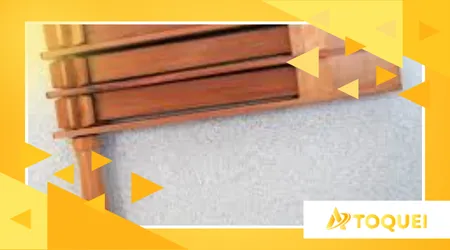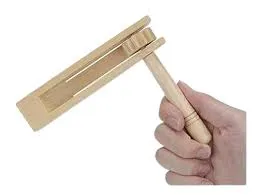What is a matraca and how is it used in Brazilian folklore?

THE rattle It is classified in organology as a struck idiophone, generally made of wood, which produces sound by the collision between pieces.
Advertisements
Basically, it consists of one or more moving blades that hit against a toothed piece, or plates that collide with each other, generating a quick and characteristic trill.
Its constructive simplicity contrasts directly with the complexity of the contexts in which it is inserted, being an instrument of great symbolic and rhythmic power.
Its name has Arabic origins mitraka, which means “wooden hammer”, indicating the antiquity and wide dispersion of this type of sound artifact throughout the world.
The function of rattle transcends mere musical accompaniment. In popular festivals, it acts as a powerful signal, a call that summons and organizes participants.
Advertisements
Its dry and intense sound is immediately recognizable, functioning as the “voice” of tradition in many festivities.
This instrument is proof that cultural richness often resides in the less obvious details of our soundscape.
How Did the Matraca Become a Central Element in the Folklore of Maranhão?
In Maranhão, the rattle assumes an unparalleled role, being the beating heart of one of the Bumba-meu-Boi accents.
This festival, which celebrates the death and resurrection of the ox, is a complex manifestation that mixes music, dance, theater and faith, recognized as Intangible Cultural Heritage of Humanity by IPHAN in 2012.
The “Sotaque de Matraca” groups, typically associated with the Island of São Luís, use the instrument on a massive scale.
The players, or “matraqueiros,” handle wooden plates that clash rhythmically, giving the accent a vigorous and contagious cadence. ]
Read more: Rebolo, tantan and repique de mão: differences and uses in pagoda
The rhythm of rattle It is what distinguishes and gives identity to these groups, creating a unique sound, almost a wall of percussive sound that accompanies the dance and songs.
The Maranhão Bumba-meu-Boi is one of the greatest examples of Brazilian folklore's ability to absorb and reinterpret popular instruments, transforming them into cultural icons.
Where Else in Brazil Does the Matraca Play a Relevant Cultural Role?
Although Maranhão is its most famous stage, the use of rattle extends to other manifestations of Brazilian folklore and religiosity.
The instrument has a strong connection with the Catholic tradition of Holy Week, especially in Minas Gerais and in some regions of the Northeast.
++ Typical frevo instruments: a beginner's guide
During the days leading up to Easter, it replaces the festive ringing of church bells, which are silenced as a sign of mourning and respect for the Passion of Christ.
The austere and shocking sound of the rattle, in this context, symbolizes the silence of pain and the solemn announcement of processions, such as the Stations of the Cross in historic cities.
This is a powerful example of how the same instrument can have completely different ritualistic functions: thunderous joy in the Bumba-meu-Boi and restrained lament in the Catholic liturgy.
To illustrate the relevance of percussion in folklore, observe the following table which shows the prevalence of percussion instruments in important Brazilian festivities.

The rattle fits perfectly into this tradition of prioritizing rhythmic intensity over melody.
| Folklore Manifestation | Main Percussive Instrument | Origin/Region of Highlight |
| Bumba-meu-Boi (Accent) | Rattle, Jaguar Drum, Tambourine | Maranhão |
| Maracatu de Baque Virado | Alfa, Caixa, Gonguê | Pernambuco |
| Capoeira | Berimbau, Atabaque, Tambourine | Bahia |
| Congada | Drums (Snare, Bass Drum) | Minas Gerais, Sao Paulo |
Why is the Rattle More Than Just a Noise Instrument?
Percussion is the backbone of Brazil's rhythmic matrix, and the matraca is an essential component of this panorama.
++ Brazilian cavaquinho vs. Portuguese cavaquinho: sound differences
Its raspy timbre, sometimes described as a “noise,” carries the rawness and strength of popular expression.
Folklore rarely seeks the politeness of chamber music; it longs for the intensity of life, the pulse of community.
The sound of the rattle, for example, is like the sound of the wheels of an old train speeding through the night, a mechanical noise that, in its context, becomes pure music, full of purpose and ancestry.
In São Luís, Bumba-meu-Boi groups rehearse in terreiros where the volume of the rattles becomes so loud that the sound wall is capable of vibrating the ground, functioning as a true rhythmic megaphone that announces the arrival of the festival.
This volume is not accidental, but part of the performance, an irresistible invitation to participate.
In contrast, in the Sabará procession, Minas Gerais, the old processional rattle, weighing several kilos and played by a single “rattler”, has a slow, low sound, punctuating the steps of penance.
The resonance of the friction of the wood as it turns is not festive; it is a murmur that invites reflection.
++ Meet the Maranhense Matraca
According to data from IPHAN's research on Bumba-meu-Boi, it is estimated that there are more than 100 active groups in Maranhão alone, with most of them preserving the Accent of Rattle.
This relevant statistic illustrates the instrument's enduring and vital role in maintaining this rich cultural manifestation.
How Does the Matraca Symbolize Resistance and Cultural Identity?
Brazilian folklore is a field of dispute and resistance, where popular manifestations fight against oblivion and cultural pasteurization.
THE rattle, with its sound that doesn't bow to hegemonic standards, symbolizes this persistence. It is the noise that popular culture makes to be heard.
Like a heart that insists on beating, the dry and tireless rhythm of the instrument represents the vitality of a tradition that refuses to die.
Analogically, the sound of the matraca in the festivities is like a cry for freedom that echoes through the nights of Maranhão, reminding everyone of the strength of the community and the beauty of popular roots.
If Brazil is a mosaic of rhythms, why neglect the forceful sound of one of its most authentic instruments?
Conclusion: The Matraca in the 21st Century
In 2025, the appreciation of instruments like the matraca is fundamental to Brazil's cultural diversity.
She reminds us that music is not limited to scales and harmonies; it is, above all, rhythm and story.
THE rattle continues to sound at festivals and processions, proving that its relevance is timeless, a vibrant testimony to our identity.
Frequently Asked Questions
1. Does the matraca have regional variations?
Yes, there are several formats. In Maranhão, they are solid wood panels interlocked.
In religious contexts, it can be a device with a toothed wheel and a pawl that rotates, generating a trill.
2. Is the matraca used in other countries?
Certainly. Instruments with a similar principle are found in various global cultures, often under the name ratchet in English or as part of liturgical traditions in European countries.
3. Is the sound of the rattle considered “musical”?
By the strict standards of classical music, it can be seen as noise.
However, in its folkloric context, the rhythm and unique timbre of the matraca are essential to the musical and rhythmic composition of the folklore, and are therefore intrinsically musical.
